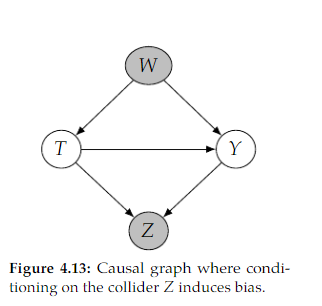Do you want BuboFlash to help you learning these things? Or do you want to add or correct something? Click here to log in or create user.
#causality #has-images #statistics


If we condition on a descendant of 𝑇 that isn’t a mediator, it could unblock a path from 𝑇 to 𝑌 that was blocked by a collider. For example, this is the case with conditioning on 𝑍 in Figure 4.13. This induces non-causal association between 𝑇 and 𝑌 , which biases the estimate of the causal effect. Consider the following general kind of path, where → · · · → denotes a directed path: 𝑇 → · · · → 𝑍 ← · · · ← 𝑌 . Conditioning on 𝑍 , or any descendant of 𝑍 in a path like this, will induce collider bias. That is, the causal effect estimate will be biased by the non-causal association that we induce when we condition on 𝑍 or any of its descendants (see Section 3.6).
If you want to change selection, open document below and click on "Move attachment"
Summary
| status | not read | reprioritisations | ||
|---|---|---|---|---|
| last reprioritisation on | suggested re-reading day | |||
| started reading on | finished reading on |
Details
Discussion
Do you want to join discussion? Click here to log in or create user.